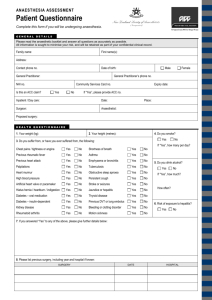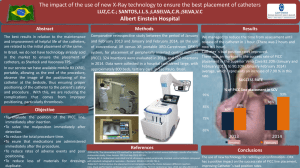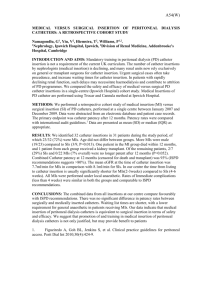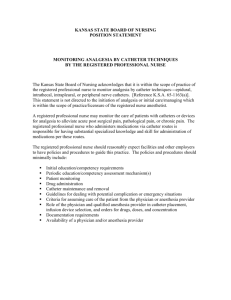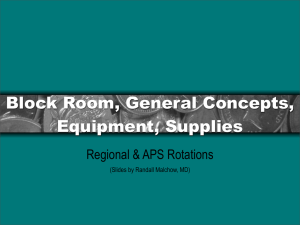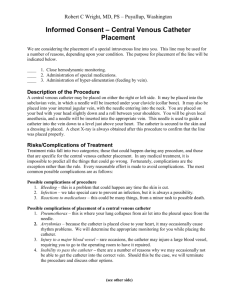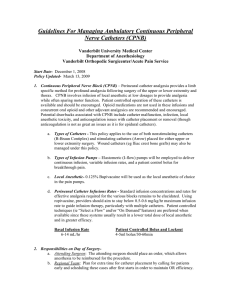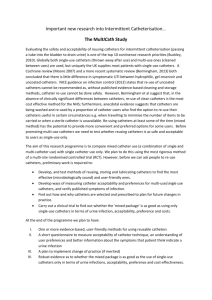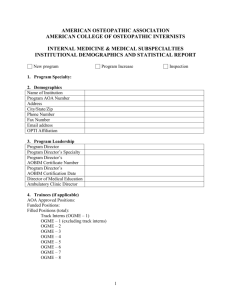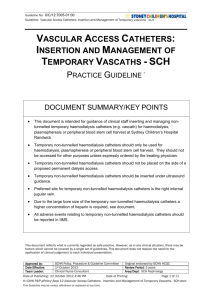Ambulatory Catheters
advertisement
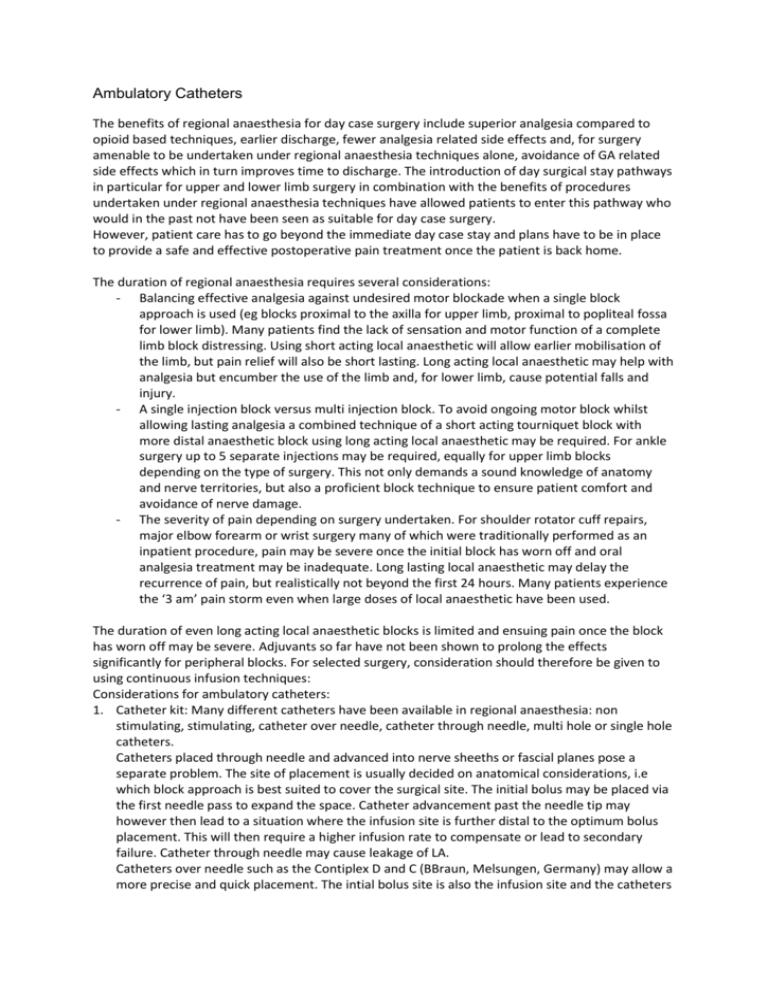
Ambulatory Catheters The benefits of regional anaesthesia for day case surgery include superior analgesia compared to opioid based techniques, earlier discharge, fewer analgesia related side effects and, for surgery amenable to be undertaken under regional anaesthesia techniques alone, avoidance of GA related side effects which in turn improves time to discharge. The introduction of day surgical stay pathways in particular for upper and lower limb surgery in combination with the benefits of procedures undertaken under regional anaesthesia techniques have allowed patients to enter this pathway who would in the past not have been seen as suitable for day case surgery. However, patient care has to go beyond the immediate day case stay and plans have to be in place to provide a safe and effective postoperative pain treatment once the patient is back home. The duration of regional anaesthesia requires several considerations: - Balancing effective analgesia against undesired motor blockade when a single block approach is used (eg blocks proximal to the axilla for upper limb, proximal to popliteal fossa for lower limb). Many patients find the lack of sensation and motor function of a complete limb block distressing. Using short acting local anaesthetic will allow earlier mobilisation of the limb, but pain relief will also be short lasting. Long acting local anaesthetic may help with analgesia but encumber the use of the limb and, for lower limb, cause potential falls and injury. - A single injection block versus multi injection block. To avoid ongoing motor block whilst allowing lasting analgesia a combined technique of a short acting tourniquet block with more distal anaesthetic block using long acting local anaesthetic may be required. For ankle surgery up to 5 separate injections may be required, equally for upper limb blocks depending on the type of surgery. This not only demands a sound knowledge of anatomy and nerve territories, but also a proficient block technique to ensure patient comfort and avoidance of nerve damage. - The severity of pain depending on surgery undertaken. For shoulder rotator cuff repairs, major elbow forearm or wrist surgery many of which were traditionally performed as an inpatient procedure, pain may be severe once the initial block has worn off and oral analgesia treatment may be inadequate. Long lasting local anaesthetic may delay the recurrence of pain, but realistically not beyond the first 24 hours. Many patients experience the ‘3 am’ pain storm even when large doses of local anaesthetic have been used. The duration of even long acting local anaesthetic blocks is limited and ensuing pain once the block has worn off may be severe. Adjuvants so far have not been shown to prolong the effects significantly for peripheral blocks. For selected surgery, consideration should therefore be given to using continuous infusion techniques: Considerations for ambulatory catheters: 1. Catheter kit: Many different catheters have been available in regional anaesthesia: non stimulating, stimulating, catheter over needle, catheter through needle, multi hole or single hole catheters. Catheters placed through needle and advanced into nerve sheeths or fascial planes pose a separate problem. The site of placement is usually decided on anatomical considerations, i.e which block approach is best suited to cover the surgical site. The initial bolus may be placed via the first needle pass to expand the space. Catheter advancement past the needle tip may however then lead to a situation where the infusion site is further distal to the optimum bolus placement. This will then require a higher infusion rate to compensate or lead to secondary failure. Catheter through needle may cause leakage of LA. Catheters over needle such as the Contiplex D and C (BBraun, Melsungen, Germany) may allow a more precise and quick placement. The intial bolus site is also the infusion site and the catheters ‘plugs’ the skin puncture to avoid leakage, but postoperative movements of the limb may potentially move the catheter from it’s optimum position. 2. Insertion procedure: The practicalities of catheter insertion may deter many practitioners from using them. Distal placed catheters may interfere with surgical preparation, if placed preoperatively, whilst postoperative insertion adds to the organisational difficulties of keeping a list going. 3. Post insertion pathways and protocols: Time required for insertion, skill for safe and accurate placement, fear of catheter related side effects or secondary failure are immediate concerns. In the ambulatory setting in particular, the setting up of protocols to cover every eventuality no matter how rare and the need to involve a large number of health care professionals in secondary and primary care in the development process have proven detrimental in many places. In the USA ambulatory catheters are used regularly and successfully, a development primarily driven by cost considerations. With the increasing financial constrictions in the UK ambulatory catheters would also be beneficial by allowing more, and more complex surgery to be undertaken as a day surgical procedure provided the safety net in the primary care setting is sufficient. This talk will primarily focus on the practicalities of catheter insertion, looking at different approaches and techniques and showing examples of practice to the benefit of selected patients.
